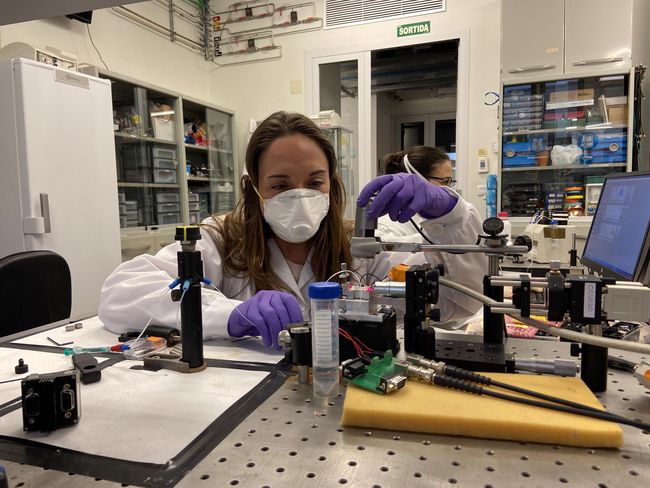BRUSSELS, April 14, 2020 — Responding to the European Commission’s call to tackle the coronavirus pandemic, photonics scientists are developing a new, rapid, noninvasive “optical biosensor” demonstrator that will detect COVID-19 in humans as soon as it is present in the body. Having already created six working laboratory demonstrators for other applications, the research team said the technology still needs further adaptation and testing but could be available in a year at the latest.
Calling themselves CONVAT and coordinated at the Catalan Institute of Nanoscience and Nanotechnology (ICN2), the researchers have tested the demonstrators on patients’ samples provided by Vall d’Hebron Barcelona Hospital Campus and several other hospitals in Spain for other pathologies.
“With thousands of deaths worldwide, we are in urgent need of a rapid new testing kit that is accurate, highly sensitive, noninvasive, and cheap to produce,” said Laura Lechuga, project coordinator.
‘Photonics is renowned for its rapid, standoff, and clean detection capabilities, so it made perfect sense to develop a device that exploited light amid this terrible pandemic.’
Originally developed to look for bacterial infections or cancer biomarkers, the new ultrasensitive device uses photonics to detect infections in patients with a small amount of the virus.
Looking at molecules, the new point-of-care detector examines virus antigens using nanophotonic biosensors from a simple nasal or saliva swab.
With the ability to diagnose in real time with high specificity from a low-concentration sample, the sensor is much more reliable than the rapid-test kit that detects whether a person has had the coronavirus before and has since recovered.
“We are currently integrating all the instrumentation in a portable 25- ×15- × 25-cm box with a tablet control,” Lechuga said. “At present, our detector is user-friendly, with the preparation being only technical expertise required, and could be widely deployed for GPs or nurses to test patients.”
The CONVAT team uses the nano-interferometric biosensor to identify the virus at the molecular level. Since the bioreceptors on the sensor surface are specifically tuned to a particular antigen of the virus, only the coronavirus molecules are captured along the sensor.
Light traveling in the sensor generates an evanescent field a few nanometers over the sensor surface where receptors can recognize the antigens of the virus capsid when a respiratory fluid sample passes through.
The recognition event produces a change in the refractive index, causing the light to slightly change its direction of travel. The researchers said this change can be measured and determined precisely against a set of existing values and could give an instant diagnosis for coronavirus expected at the picomolar to attomolar range without any need amplification.

Convat laboratory at the ICN2. Courtesy of CONVAT.
“Our patented interferometric technology is unique for biosensing,” Lechuga said. “We use our bimodal waveguide interferometer, which uses two modes of a light beam at the visible wavelength travelling in a single waveguide.”
Lechuga said the light interacts with analytes during their travel. At the end of the bimodal waveguide, the research team records the interference between both light modes, and then the signal is collected with a photodetector and processed by electronics instantly.
“Photonics is renowned for its rapid, standoff, and clean detection capabilities, so it made perfect sense to develop a device that exploited light amid this terrible pandemic,” Lechuga said.
While previous results were promising, Lechuga said the team’s sensor will be further optimized and evaluated for viral RNA analysis in a multiplexed format for more accurate diagnosis and identification of virus strains among different coronaviruses and other clinically relevant viruses.
“The CONVAT team is working around the clock to develop a rapid, noninvasive test for coronaviruses,” said Jurgen Popp, chair of the Photonics21 Healthcare Workgroup. “The ability to spot this terrible virus quickly will contribute to the worldwide effort in fighting [the virus] and highlights yet another success for photonics and light technologies.”
Philippe Vannson, head of the Photonics Unit, DG CONNECT, at the European Commission, said, “Light-based technologies are providing tools and solutions to every industry in every region in the world. By creating Instant diagnosis of major diseases, photonics is making health care fast, precise and cost-effective.”
“In just eight days we worked more than 12 hours per day to put together a consortium of four partners, writing a successful proposal to the EC,” Lechuga said. “It was approved and now I’ve been contacted by the Spanish minister for science and innovation and invited onto TV and radio talk shows.”
Funded by Horizon 2020, the European Commission’s scientific research initiative, the scientists began work on their detector at the start of March in response to the pandemic.